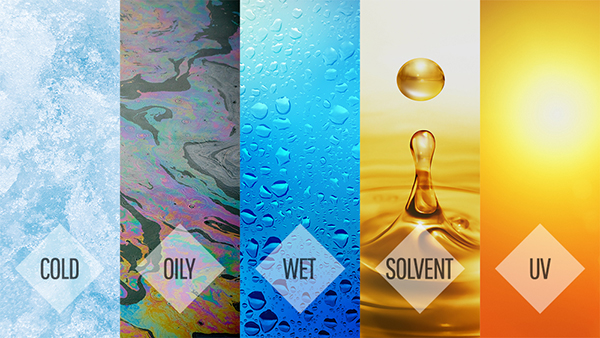
Say you ship drums of UN 1263 paint every single day. You know the applicable regulations for shipping 1263 like you know your kids’ middle names. You could wallpaper your entire facility with the shipper’s declarations for 1263 you’ve printed over the years. Your phone passcode is 1263.
You’re as likely to ship UN 1263 non-compliantly as you are to start at linebacker in next year’s Rose Bowl.
And then you get a drum returned. A frustrated shipment. What the heck?
Turns out, your 1263 placard fell off the drum when the truck went through that ice storm that slammed Oklahoma. A state trooper flagged the placard-less drum during a spot inspection.
Mother Nature has no respect for your Dangerous Goods compliance record. That’s why we’ve introduced hazmat labels, placards and marks for extreme conditions.
The best labels, placards and marks for your worst conditions
Our standard Dangerous Goods labels, marks and placards are designed to endure most normal shipping conditions without fading, peeling or losing adherence. But—from bone-chilling Montana highways to sweltering Texas warehouses—your shipments may sometimes face conditions that are anything but normal.
Hazmat labels, placards and marks endure some of the most brutal conditions on earth. And if they fail, you fail. To keep your shipments compliant no matter how nasty conditions get, our new “extreme” labels, placards and marks endure the harshest environments your supply chain can dish out.
If your Dangerous Goods always travel in warm, dry, clean, well-shaded environments, stop reading. But if you ever deal with harsh conditions, here are five situations where you might need to think “extreme.”
Cold Environments
Polar blizzards? Industrial freezers? No problem! With material designed for cryogenic laboratories, these labels and placards adhere down to -320°F. The edges resist lifting even with repeated changes in the surrounding temperature.
Oily Surfaces
Your degreasing days are done. The adhesive backing on these labels and placards absorbs oil, so it adheres directly to lubricated surfaces—textured or smooth.
Wet Surfaces
Dominate the damp with a high-tack rubber-based adhesive that keeps these labels and placards adhered. They also stay stuck to low- and high-energy substrates and can be applied from 10°F to 150°F. Useful anywhere.
Solvent Exposure
Sprayed, abraded, baked or abused? No worries. These placards or labels stand up to the harshest conditions for extended periods. They offer superior chemical and abrasion resistance while also resisting acids, humidity, high temperatures and UV exposure.
Ultraviolet Exposure
Arizona? Dubai? Bring it on! The topcoat of these labels and placards resists fading and deterioration for up to two years, and offers superior resistance to acids, moisture and solvents from -40°F to 257°F.
Not for hazmat only!
Because we recognize that your organization may have documentation adherence needs (i.e., information that sticks to stuff) beyond the world of hazmat transport, we can create customized labels or placards for virtually any use under any conditions—for Dangerous Goods and beyond.
A few potential examples:
- Cold labels for laboratories and cryogenics facilities
- Wet labels compliant with FDA Indirect regulation
- UV-resistant labels and placards for BS5609 Certified Section Two, Marine Immersion
Need solutions for your most challenging conditions? Call Labelmaster at 800.621.5808.
For a closer look at our new Dangerous Goods labels, placards and marks for harsh environments, visit our Extreme Conditions page.
Labelmaster is a full-service provider of goods and services for hazardous materials and Dangerous Goods professionals, shippers, transport operators and EH&S providers. See our full line of solutions at labelmaster.com.


